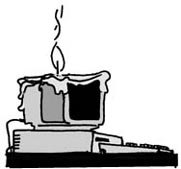![[MetroActive Features]](/features/gifs/feat468.gif)
[ Features Index | San Jose | MetroActive Central | Archives ]
 Illustration by Jeremy Russell SGI Goes Bust, Part II Insider talks about how NT killed the graphics star By Annalee Newitz Under the protection of a pseudonym, SGI insider Dominic has been telling me the tragic and bitter tale of his company's decline. The once-great Silicon Valley graphics workstation giant, plagued by poor business decisions, a high-level talent drain and mammoth financial losses, has recently been downsized to a mere shadow of its former self. How did it all happen, and so quickly? According to Dominic, SGI acted on the biztech equivalent of a death wish when execs decided to hop in bed with notorious corporate serial killer Microsoft. "Marketing looked at the size of the NT business and said that if we only captured a small percentage of this market we'd have made more money than we made on UNIX workstations in the previous year," Dominic recalled, looking like a trauma victim. SGI, as Dominic put it with strained vagueness, "exchanged various and sundry things" for the source code to NT. The company began working on an NT machine which eventually became the Visual Workstation. Ironically, this machine was given the code names Hugh and Borg, references to Star Trek's scariest life form, whose mantra could be Microsoft's business credo: "resistance is futile--you will be assimilated." Not only did SGI throw its energies in NT, but it also abandoned the MIPS chip for Intel. The new NT-plus-Intel box--it could have been called SELLOUT, in reference to the INDY--was a disaster. Not only was it late to market, but, for reasons Dominic still finds mysterious, "it used 3.3 volt PCI boards instead of the industry standard 5 volt. The explanation we got was that the 3.3 would eventually become standard, but that ignored the fact that the current crop of cards was what most people were using. Ultimately, it was just a dumb move." As SGI's once-unassailable reputation began to crumble, there came the inevitable changes in corporate policy and organization. Unlike previous SGI projects, the NT workstation had been done mostly in secret, which Dominic noted was "not the SGI way," and that created a lot of tension as a result. And then, around 1997, SGI began to phase out its software production. "The logic was that the reason why we were doing NT was for all its supported software. So why did we need our own software? The idea was that NT would save everything and we didn't need to do UNIX." SGI had invented its own flavor of UNIX, known as IRIX, and as more and more false hopes were invested in NT, the divisions which had once been responsible for IRIX began to die. SGI's hardware divisions had always done their own software. But suddenly SGI decided to create a software division within the company known as the Strategic Software Organization (SSO), managed by VP Denise Gibson. It was the perfect double-think move, paradoxically yanking funding out of software by creating a new software department. What looked like a new commitment to software was actually a way of containing and eliminating what had once been a thriving source of intellectual capital. "That's when the majority of the talent walked out," Dominic sighed. He continued, "SSO worked by having a hardware department pony up money to put in the SSO pot, and then they would get their software." Departments started having turf wars and playing "budget chicken." Each organization would try to go as long as possible without the software they needed so they could get other departments to dump money into SSO first. Dominic realized that this division of labor served nobody's interests. "Whoever needed software the most ended up losing money, and inevitably that was the server organization, who paid for almost everything. And as you can imagine, very little got done at this time because nobody wanted to pay for it." Dominic found that the most telling signs of end times at SGI was a subtle change in personal relationships between colleagues. Where once managers had taken responsibility for mistakes, suddenly all kinds of problems were being blamed on engineers. Within the last few months it's been said that it's better to be from SGI than at SGI. Dominic agrees. "Some people are sticking around for their sabbatical or in the hope that the company might get bought out and their stock options might actually be worth something." "Wow," I interject. "That's harsh." Dominic shrugs. "That's fuckin' reality, though." To reach surly media nerd Annalee Newitz, email her at tabloid@jps.net. [ San Jose | MetroActive Central | Archives ]
|
From the November 4-10, 1999 issue of Metro, Silicon Valley's Weekly Newspaper.
Copyright © 1999 Metro Publishing Inc. MetroActive is affiliated with the Boulevards Network.
For more information about the San Jose/Silicon Valley area, visit sanjose.com.